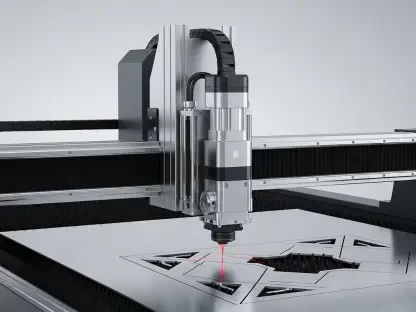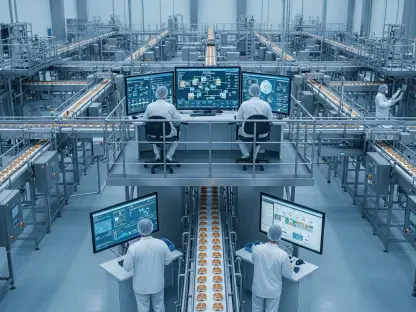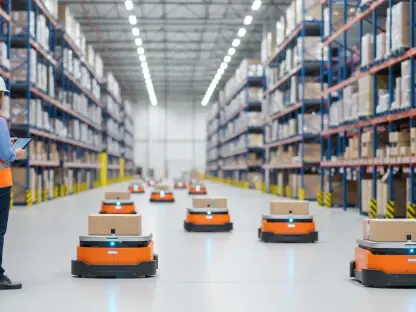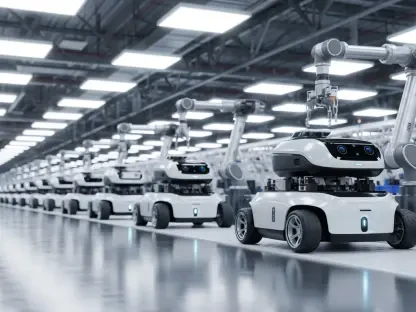The world of modern manufacturing leans heavily on versatility and adaptability, exemplified by butadiene’s significant role across various sectors. This highly reactive, colorless gas with the chemical formula C4H6 is a fundamental by-product of ethylene production through steam cracking, contributing to a wide range of industrial applications. Butadiene is valued not only for its role in synthetic rubber production but also for its ability to undergo polymerization, making it a crucial building block in the chemical industry. Its derivatives, such as styrene-butadiene rubber (SBR) and polybutadiene rubber (PBR), dominate applications in sectors from automotive to healthcare, showcasing its indispensable role. The global demand for butadiene is further driven by its characteristics of flexibility, durability, and thermal resistance, especially in industries looking to meet the ever-growing performance standards of modern products. As industries evolve towards more sustainable practices, butadiene’s versatility remains a powerful asset, navigating traditional sectors and emerging markets alike.
Butadiene in Automotive and Transportation Industries
In the automotive industry, butadiene plays a pivotal role due to its applications in producing synthetic rubbers like PBR and SBR. These materials are renowned for providing excellent abrasion resistance and high durability, making them ideal for manufacturing tires, hoses, belts, and gaskets. The automobile sector, which continually faces the demand for improved safety, performance, and efficiency, heavily relies on these butadiene-derived rubbers. Car tires, often engineered to handle various terrains and weather conditions, benefit from the resilience that butadiene offers, ensuring longer lifespans and enhanced grip. Furthermore, butadiene’s high resistance to mechanical stress and temperatures adds a layer of reliability in harsh driving conditions. This reliability is critical as manufacturers constantly push boundaries with electric vehicles and autonomous technologies. The continued demand for durable, high-performance vehicle components ensures butadiene’s enduring presence in this dynamic sector, consistently aligning with innovative automotive solutions.
Beyond traditional rubber applications, butadiene’s role extends into producing materials that influence aspects of vehicle design, such as lightweight composites used in structural components. The shift towards lightweight vehicles for better fuel efficiency without compromising safety directly benefits from polymers developed from butadiene. These materials offer a blend of robustness and flexibility, crucial for mitigating the effects of impacts while enhancing overall vehicle stability. As transportation infrastructures adapt to new green policies and electric vehicle advancement, the necessity for innovative materials compatible with next-generation vehicles further solidifies butadiene’s importance. Whether in conventional cars or the latest electric modes, its adaptability ensures that automotive solutions continue to meet industry challenges, fulfilling customer expectations across varied landscapes.
Influence on Construction and Infrastructure
Butadiene’s impact on the construction industry is profound, primarily through its derivatives like nitrile rubber and SBR latex. These components serve as foundational materials in crafting sealants, adhesives, and membranes vital for constructing durable infrastructures. Buildings and roadways benefit from the enhanced sealant properties afforded by butadiene, contributing to the longevity of these structures despite varying environmental pressures. For instance, roofing and flooring materials made with butadiene derivatives ensure these surfaces can efficiently withstand moisture and temperature fluctuations. The inherent weatherability and flexibility of these compounds enable structures to remain secure and resilient, a necessity in both urban developments and rural constructions. Such properties are essential in a field where environmental conditions constantly challenge material integrity, mandating that built environments adapt and endure over time.
In construction’s ever-changing landscape, butadiene also facilitates innovative applications in sustainable infrastructure development. The need for eco-friendly building materials fuels the exploration of bio-based butadiene derivatives, aligning construction practices with environmental goals. These advances aim to reduce carbon footprints associated with traditional manufacturing and extend the life cycle of construction materials through sustainable means. By enhancing the mechanical properties of construction components while adhering to environmental regulations, butadiene pivots traditional practices towards greener solutions, ensuring compliance with both governmental standards and consumer demand for sustainable buildings. As cities grow and the push for smarter, environmentally-friendly infrastructure intensifies, butadiene remains a core element driving quality and innovation in construction.
Electronics and Electrical Industry Applications
The electronics and electrical industries benefit extensively from acrylonitrile butadiene styrene (ABS), a plastic derived from butadiene. ABS is a crucial material prized for its durability and impact resistance, two qualities highly sought after in developing electronic housings, connectors, and insulating components. In consumer electronics, such as laptops and mobile phones, ABS provides the structural integrity necessary to protect sensitive components from physical shocks and temperature variations. Its lightweight and moldable properties allow for the cost-effective production of complex and detailed parts, integral in high-volume manufacturing scenarios. Given its heat stability and resistance properties, ABS plastic retains its form and function even under the demanding conditions commonly associated with electronic devices, highlighting butadiene’s indispensable contributions to this technological era.
The electronics industry’s rapid evolution creates constant demand for advanced materials, and butadiene plays a central role in satisfying these needs. As innovation accelerates in sectors like telecommunications and computing, requiring refined materials that offer both strength and versatility becomes imperative. ABS’s contribution extends beyond consumer electronics to include smaller parts crucial in larger electrical installations and systems, ensuring that operational safety and efficiency remain uncompromised despite continuous use. Butadiene’s adaptability allows for creating tailored materials that meet industry-specific requirements, ensuring that rapid technological advancements are supported by equally capable materials. As the world progresses toward digitalization and smarter solutions, the material capabilities offered by butadiene derivatives continue to break new ground, reinforcing its value in enriching electronics manufacturing processes.
Contributions to Agriculture and Fertilizers
In agriculture, butadiene contributes indirectly by enhancing the durability of essential rubber-based parts used in farming equipment. Tractors, irrigation systems, and other machinery integral to farm operations rely heavily on components like rubber belts, tires, and hoses made from butadiene-based polymers. These materials provide the necessary flexibility and resilience to withstand the rigorous demands of daily agricultural activities. The extended lifespan and reliability of butadiene-enhanced components reduce wear and tear, translating into operational efficiency and lower maintenance costs for agricultural businesses. As farming scales up to meet the growing demands of global food production, having dependable equipment becomes crucial, with butadiene playing an understated yet essential role.
Additionally, as the agriculture industry faces increasing pressure to adopt sustainable practices, butadiene’s flexibility extends into eco-friendly product advancements where bio-based alternatives are being researched to diminish environmental impacts. Renewable variants of butadiene hold promise in reducing dependency on traditional petrochemical sources, aligning agricultural machinery development with global sustainability goals. This balance between performance and environmental stewardship represents a significant advancement in how fundamental materials like butadiene integrate into sustainable agricultural innovations. As demands for productivity and sustainability grow in tandem, butadiene-based materials are expected to play an even more strategic role, driving technological advancements that affirm its relevance in modern agricultural landscapes.
Healthcare and Pharmaceutical Applications
In healthcare, butadiene-based polymers play a critical role in producing medical-grade elastomers like nitrile rubber. These materials are essential for creating products such as catheters, medical tubing, and gloves, which demand superior flexibility and chemical resistance. Nitrile rubber, in particular, is valued for offering reduced allergenicity compared to traditional latex materials, providing safer alternatives in medical settings where latex allergies are a significant concern. The durability and sterility of butadiene-based elements align with the stringent requirements in healthcare environments, ensuring these products maintain their quality and functionality over extended periods. The capability of nitrile rubber to undergo repeated sterilization processes without degrading is pivotal, securing its place as a fundamental material in medical device manufacturing.
Butadiene’s influence extends within the pharmaceutical sector, where ABS plastics, due to their sterilizable nature, find myriad applications in medical device housings and related components. These applications require stringent safety and performance criteria to ensure the well-being of patients and healthcare professionals. Inhalers and diagnostic devices benefit from ABS’s resistance to impact and capacity to withstand regular cleaning processes. Butadiene derivatives contribute to elevating healthcare capabilities, facilitating innovations that drive improved patient outcomes. As the healthcare industry evolves amidst increasing technological advancements and regulatory demands, butadiene and its derivatives continue to offer versatile solutions, reinforcing their role in enhancing medical device development and improving global healthcare systems.
Emerging Trends and Market Demand
The demand for butadiene, a vital petrochemical intermediate, is intricately linked to industrial growth, especially within the manufacturing and transportation sectors. As industries undergo transformation powered by advancements in technology and shifting market dynamics, butadiene’s adaptability proves crucial in meeting these evolving needs. This chemical’s reactivity and versatility underpin its stronghold in producing high-performance polymers such as SBR, PBR, and ABS, reinforcing its centrality in manufacturing high-demand products. Historically, the automotive industry has represented butadiene’s largest consumer, driven by the ongoing requirement for tires and rubber components. Alongside this, the construction, electrical, and consumer goods sectors fuel butadiene consumption through various applications, including adhesives and flooring.
New avenues for butadiene applications are emerging to align with trends such as renewable energy adoption and the proliferation of advanced healthcare technologies. The rise of electric vehicles (EVs) creates fresh demand for lightweight, durable polymer components that butadiene helps to address, capitalizing on the need for innovative yet efficient parts in next-generation transportation. Additionally, advancements in medical technology highlight butadiene’s importance in creating health-focused products that elevate patient care quality. As these sectors continue to expand globally, butadiene’s capability to drive product innovation while maintaining cost-effectiveness and availability cements its position as an indispensable component in the evolving industrial landscape.
Sustainable Developments and Innovations
Ongoing research and development efforts are broadening the scope of butadiene applications, particularly with an eye on sustainability and renewable resource utilization. Researchers are making headway in developing bio-based and sustainable variants of butadiene derived from renewable sources such as bioethanol or glycerol. These eco-friendly alternatives aim to reduce reliance on fossil fuels, offering a sustainable pathway forward without compromising the performance attributes synonymous with traditional butadiene. The chemical industry is responding to environmental pressures and regulatory guidelines by exploring these sustainable options, identifying pathways that can lower carbon emissions and minimize ecological impact, all while maintaining material integrity and performance standards.
Innovations are manifesting within sectors like electric vehicles, aerospace, and medical devices, where bio-based butadiene and its derivatives offer potential breakthroughs in creating lightweight, high-performance materials essential for cutting-edge technological applications. Electric vehicle manufacturing stands to benefit significantly from this, as automakers seek to incorporate sustainable components in their designs to meet global environmental commitments. In aerospace, attention is drawn to materials offering both strength and minimal weight, particularly as companies look to sustain innovative design processes. By broadening the material base with sustainable butadiene alternatives, industries can adhere to sustainability mandates and better position themselves to meet consumer and regulatory expectations in the pursuit of a greener future.
Case Studies Reflecting Butadiene Innovation
Global enterprises are capitalizing on butadiene’s flexibility, demonstrating its potential in various industry applications. One significant example is Michelin, which employs butadiene derivatives like SBR and PBR to enhance tire performance, focusing on qualities such as fuel efficiency, grip, and durability. Tire companies emphasize reducing petrochemical reliance and investing in research on bio-based butadiene to lower their products’ carbon footprint. Another company, LANXESS, has explored bio-based butadiene production from renewable sources by partnering with Genomatica, aiming to commercialize sustainable synthetic rubber for automotive and industrial applications while ensuring performance metrics are met.
BASF further exemplifies innovative use by integrating ABS into electronics and appliances to produce heat-resistant components. With developments in specialty ABS grades for medical devices and automotive interiors, the company underscores the importance of meeting high-performance and safety benchmarks while pushing for innovative solutions. Bridgestone’s initiative in creating butadiene monomers from bioethanol demonstrates dedication toward circular economy practices by setting a vision to use 100% sustainable materials in tire production by 2050, showcasing a proactive approach in navigating environmental practices and supporting eco-friendly product solutions across their ranges. These cases represent tangible outcomes of integrating butadiene into processes, driving both technological advancement and sustainable innovation.
Future Considerations for Butadiene Utilization
In the automotive industry, butadiene is integral due to its role in producing synthetic rubbers such as PBR and SBR. These rubbers are known for their exceptional abrasion resistance and durability, ideal for making tires, hoses, belts, and gaskets. The auto sector, always striving for better safety, performance, and efficiency, heavily depends on these butadiene-based materials. Car tires, designed to endure a variety of terrains and weather conditions, gain from butadiene’s resilience, providing a longer lifespan and superior grip. Additionally, butadiene’s high resistance to mechanical stress and extreme temperatures makes it a reliable choice in tough driving scenarios. As carmakers explore electric vehicles and autonomous technologies, this reliability is vital. The demand for tough, high-quality vehicle parts keeps butadiene relevant, matching the pace of automotive innovation.
Beyond traditional uses, butadiene is also vital in creating materials that influence vehicle design through lightweight composites used in structural parts. As the industry shifts towards lighter cars for improved fuel efficiency without sacrificing safety, it benefits from butadiene-derived polymers. These materials offer strength and flexibility, crucial for absorbing impacts and boosting vehicle stability. With green policies and electric vehicle growth, the need for innovative, compatible materials solidifies butadiene’s importance. Whether in conventional or electric vehicles, its adaptability ensures that automotive solutions meet industry challenges and exceed consumer expectations across various landscapes.









